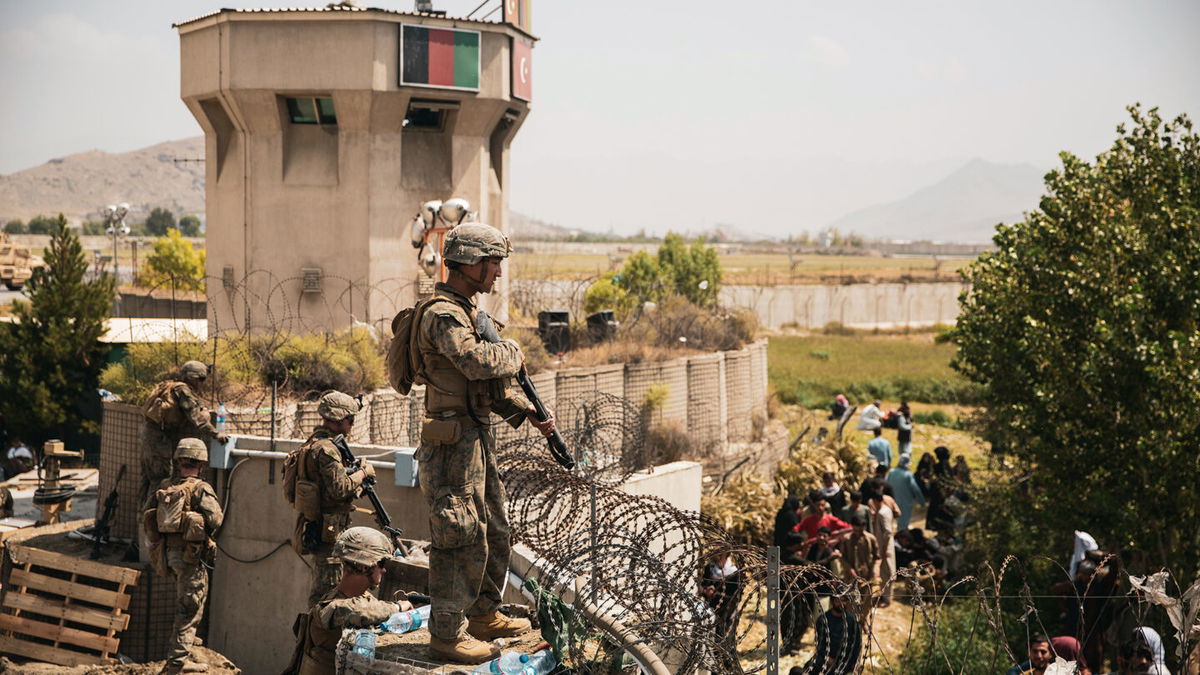State Department review of US withdrawal from Afghanistan includes far more findings than White House document

US Marines assist with security at an evacuation control checkpoint during an evacuation at Hamid Karzai International Airport in Kabul
By Kylie Atwood and Jennifer Hansler, CNN
The State Department’s review of the US withdrawal from Afghanistan has far more findings in it than the document about the withdrawal that the White House released Thursday afternoon, according to a source familiar with the report.
While the White House’s document focused on President Joe Biden having been “severely constrained” by the conditions created by former President Donald Trump, the State Department report has more than two dozen recommendations — some specifically related to how the department could have better prepared, including during the Biden administration, the source said.
“The Biden administration inherited a deadline without a clear plan of how to get there, but they then undertook their own review. And in April, Biden decided to go ahead with it and delayed the withdrawal timeline. So they did not exactly take the blueprint they were given in that regard. So some of that is a bit disingenuous to say that their hands were completely tied,” the source said, explaining their view on the need for the Biden administration to take some ownership for the conduct of the withdrawal.
The White House document does note that upon reflecting on the withdrawal, the State Department and the Pentagon “now prioritize earlier evacuations” when faced with a degrading security situation. But the document also defends the time for when the evacuation from Afghanistan occurred, citing interagency meetings and decision-making at the time.
The White House document also says that the US government now errs “on the side of aggressive communication about risks” when there is a destabilizing security environment.
But it is unclear why the White House document assessing the challenges and decisions surrounding the withdrawal did not cite the wide number of recommendations from the State Department report, which was the result of an intensive 90-day review. A spokesperson for the National Security Council, or NSC, said the document was a “separate product” that was “informed” by the various departments’ reviews.
The State Department’s much more detailed after-action report was sent to Capitol Hill on Thursday, but otherwise the department has not widely released any of the findings more than a year after the report’s completion. The report itself was launched by Secretary of State Antony Blinken in December 2021. Employees who worked on the chaotic evacuation have clamored for details as to what the department learned from the after-action report.
An NSC spokesperson said the department’s reviews “were not undertaken for public release but to improve internal processes.”
On Thursday, the department scrambled to put together a town hall for employees to discuss the report with Blinken and Undersecretary for Management John Bass, who was a key official in the Afghanistan withdrawal, according to three employees who attended the event.
Blinken described the report to employees without sharing it. He said that it detailed the processes, systems and mindsets that could have been improved, including the need for more urgent preparations for worst-case scenarios, employees said.
Blinken said contingency preparations were inhibited by concerns that they would be too visible and would prompt concerns by Afghan officials, employees told CNN. The top US diplomat also pointed to competing and conflicting views in Washington about how to prioritize categories of evacuees, and he acknowledged that the department’s database technology and communications infrastructure were inadequate.
The employees said that, according to Blinken, the report makes 34 recommendations. They include strengthening the department’s crisis-response capabilities, appointing a single senior official for future complex crises, enhancing crisis communications such as call centers, building a so-called red team to challenge assumptions and running more tabletop exercises, employees said.
But for many employees, the town hall only led to more frustrations about a lack of full transparency. The source familiar with the full report explained that the findings were purposefully not classified so they could be widely shared if the department chose to do so, but so far that has not happened.
At least one employee was emotional during the town hall, criticizing how hastily it was arranged and the decision not to share the full report. Blinken cited concerns about politicizing the report and looking backward instead of forward, employees said.
The State Department did not respond to a request for comment regarding the town hall or any plans to share parts of the department’s report more widely.
This story has been updated with additional information.
The-CNN-Wire
™ & © 2023 Cable News Network, Inc., a Warner Bros. Discovery Company. All rights reserved.